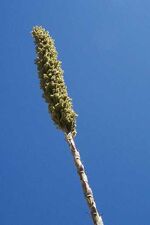Tucson is a city and the county seat of Pima County, Arizona. As of the 2000 census, the city had a total population of 486,699, with a metropolitan-area population of 843,746. A July 1, 2003 Census estimate put the city's population at 507,658. It is the largest city in southern Arizona, and the second largest in the state after Phoenix. The name Tucson comes via Spanish from the O'odham, meaning "Black Foothills," a reference to the mostly volcanic mountains on the west side of the city. The most notable of these foothills is Sentinel Peak, better known as "A Mountain" because it sports a large letter A in honor of the University of Arizona. Tucson is sometimes referred to as "The Old Pueblo."
History[]
- (A substantial article Tucson:History is being considered.)
Tucson was originally inhabited around 7000 BC by early Paleo-Indians, and later replaced by groups designated by archaeologists as the Hohokam. As such, Tucson is the longest continuously inhabited location in the United States.
Jesuit missionary Eusebio Francisco Kino visited the area in 1692, and founded the Mission San Xavier del Bac in 1700. The Spanish established a presidio (fort) in 1776 and the town came to be called "Tucson." Tucson became a part of Mexico after Mexico gained independence from Spain in 1821. Following the Gadsden purchase in 1853, Tucson became a part of the United States of America. From August 1861, until mid-1862, Tucson was the capital of the Confederate States of America|Confederate Territory of Arizona. Until 1863, Tucson and all of Arizona was part of the New Mexico Territory. From 1867 to 1889, Tucson was the capital of the Arizona Territory. The University of Arizona, located in Tucson, was founded in 1885.
Geography[]
Tucson is located at 32°12'52" North, 110°55'5" West (32.214476, -110.918192).
Tucson's elevation is 2,389 ft (728 m) above sea level. Tucson is bounded by four sets of mountains: the Santa Catalina Mountains to the North, the Santa Rita Mountains to the South, the Rincon Mountains to the East, and the Tucson Mountains to the West. The city is located on the Santa Cruz River.
Demographics[]
As of the census of 2000:
- There were 486,699 people, 192,891 households, and 112,455 families residing in the city.
- The median income for a household in the city was $30,981, and the median income for a family was $37,344. Males had a median income of $28,548 versus $23,086 for females. The per capita income for the city was $16,322. 18.4% of the population and 13.7% of families were below the poverty line. Of all the people living in poverty, 23.6% of those under the age of 18 and 11.0% of those 65 and older were living below the poverty line.
Institutions[]
Tucson is home to the University of Arizona, a state-run land-grant university which provides many jobs and economic stimulus to the local economy. Davis-Monthan Air Force Base, located on the southeastern edge of the city, also provides many jobs for Tucson residents. The city's largest private employer is the Raytheon missile factory.
Attractions[]
- Biosphere 2 is located north of the city.
- Mission San Xavier del Bac, a historic Spain|Spanish mission, is 10 miles (16 km) south of the city.
- Old Tucson Studios, a movie studio for classic Western movie|Westerns and a theme park, is located west of the Tucson Mountains.
- The Arizona-Sonora Desert Museum, a zoo devoted to Southwestern animals and plants, is located to the west of the Tucson Mountains.
- Pima Air & Space Museum, featuring over 250 modern and historical aircraft, is located to the southeast of the city near Davis-Monthan Air Force Base.
- The Titan Missile Museum, a Cold War era Titan (rocket family)|Titan nuclear missile silo turned tourist stop, is located about 25 miles (40 km) south of the city along Interstate 19.
- 4th Avenue, near the University of Arizona, is home to many shops, restaurants, and bars. Hosts the 4th Avenue Street Fair in December and March.
- Tucson Botanical Gardens
- Sabino Canyon is a scenic hiking destination, with some areas that are quite lush considering the local climate.
- Saguaro National Park has sections east and west of the city.
- The University of Arizona campus has an arboretum and several museums.
Annual gem & mineral show[]
The Tucson Gem & Mineral Show is held every year in February for two weeks (open + one week for professionals). It is one of the largest and most well-known gem and mineral shows anywhere, and it features the many of the finest mineral specimens available. There is no single location for display of minerals, but rather dozens of locations spread across town: many big hotels and most motels are occupied for the occasion, professionals even display their specimens in hotel bedrooms, lobbies, under tents, and on lawns. The show has an estimated attendance of more than 35,000 people from over twenty countries. Attendees frequently include the general public, experts, beginning collectors, museum employees, dealers, retailers, and researchers. Many museums and universities, including the Smithsonian Institution and the Sorbonne, have displayed materials at the show.
External links[]
- University of Arizona Webcam, Tucson
- El Presidio Plaza Webcam, Tucson
- City of Tucson
- Official tourism site
- Arizona Daily Star morning daily broadsheet newspaper
- Tucson Citizen afternoon daily broadsheet newspaper
- Tucson Weekly gratis weekly tabloid newspaper
| This page uses content from the Old Pueblo Wiki aka Tucson Wiki (with the approval of the founder of that wiki). The original content was at Tucson. The list of authors can be seen in that page's history if it is still extant. As with this Cities Wiki wiki, the content of any Wikia is available under the GNU Free Documentation License. |

